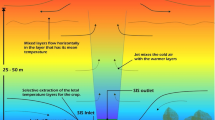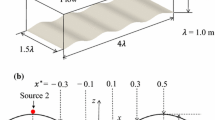Abstract
The paper deals with steady-state turbulent fountains in a homogeneous surrounding. A set of mono-dimensional conservation equations is first derived from the Navier–Stokes equations. In contrast with equations used for plumes or rising fountains, these equations reveal additional terms in order to account for the effect of the (annular) down-flow on the fountain up-flow. Large-eddy simulations are then performed and used to determine, from radial profiles, the values of the constants (associated with these additional terms) to be fitted in the model. With these constants, analytical solutions of the model for steady-state fountain are proposed and compared with previous experiments.










Similar content being viewed by others
Notes
The CFD code ISIS can be freely downloaded from the following website: https://gforge.irsn.fr/gf/project/isis/.
References
Abraham G (1967) Jets with negative buoyancy in homogeneous fluid. J Hydraul Res 5:235–248
Ansong JK, Kyba PJ, Sutherland BR (2008) Fountains impinging on a density interface. J Fluid Mech 595:115–139
Babik F, Lapuerta C, Suard S (2011) ISIS 3.0.0.: Physical Modelling. Technical report SEMIC-2011-054. Institut de Radioprotection et de Sûreté Nucléaire
Baines WD, Turner JS, Campbell IH (1990) Turbulent fountains in an open chamber. J Fluid Mech 212:557–592
Bloomfield LJ, Kerr RC (1998) Turbulent fountains in a stratified fluid. J Fluid Mech 358:335–356
Bloomfield LJ, Kerr RC (1999) Turbulent fountains in a confined stratified environment. J Fluid Mech 389:27–54
Bloomfield LJ, Kerr RC (2000) A theoritical model of a turbulent fountain. J Fluid Mech 424:197–216
Burridge HC, Hunt GR (2013) The rhythm of fountains: the length and time scales of rise height fluctuations at low and high Froude numbers. J Fluid Mech 728:91–119
Burridge HC, Hunt GR (2012) The rise heights of low- and high-Froude-number turbulent axisymmetric fountains. J Fluid Mech 691:392–416
Campbell IH, Turner JS (1989) Fountains in magma chambers. J Petrol 30:885–923
Candelier F, Vauquelin O (2012) Matched asymptotic solutions for turbulent plumes. J Fluid Mech 699:489–499
Carazzo G, Kaminski E, Tait S (2010) The rise and fall of turbulent fountains: a new model for improved quantitative predictions. J Fluid Mech 657:265–284
Chong MS, Soria J, Perry AE, Chacin J, Cantwell BJ, Na Y (1998) Turbulence structures of wall-bounded shear flows found using DNS data. J Fluid Mech 357:225–247
Clanet C (1998) On large-amplitude pulsating fountains. J Fluid Mech 366:333–350
Cresswell RW, Szczepura RT (1993) Experimental investigation into a turbulent jet with negative buoyancy. Phys Fluids A 5:2865–2878
Friedman PD (2006) Oscillation in height of a negatively buoyant jet. Trans ASME J Fluids Eng 128:880–882
Geyer A, Phillips JC, Mier-Torrecilla MD, Idelsohn SR, Oate E (2012) Flow behaviour of negatively buoyant jets in immiscible ambient fluid. Exp Fluids 52(1):261–271
Hunt GR, Coffey CJ (2009) Characterising line fountains. J Fluid Mech 623:317–327
Kaminski E, Tait S, Carazzo G (2005) Turbulent entrainment in jets with arbitrary buoyancy. J Fluid Mech 526:361–376
Kaye NB, Hunt GR (2006) Weak fountains. J Fluid Mech 558:319–328
Kaye NB (2008) Turbulent plumes in stratified environments: a review of recent work. Atmos Ocean 46:433–441
Lin W, Armfield SW (2000) Direct simulation of of weak axisymmetric fountains in a homogeneous fluid. J Fluid Mech 403:67–88
Lin YJP, Linden PF (2005) The entrainment due to a turbulent fountain at a density interface. J Fluid Mech 542:25–52
McDougall TJ (1981N) Negatively buoyant vertical jets. Tellus 33:313–320
Mehaddi R, Vauquelin O, Candelier F (2012) Analytical solutions for Boussinesq fountains in a linearly stratified environment. J Fluid Mech 691:487–497
Michaux G, Vauquelin O (2008) Solutions for turbulent buoyant plumes rising from circular sources. Phys Fluids 20:066601
Mizushina T, Ogina F, Takeuchi H, Ikawa H (1982) An experimental study of vertical turbulent jet with negative buoyancy. Wärme Stoffübertrag 16:15–21
Morton BR, Taylor GI, Turner JS (1956) Turbulent gravitational convection from maintained and instantaneous sources. Proc R Soc Lond A 234:1–23
Morton BR (1959) Forced plumes. J Fluid Mech 5:151–163
Nicoud F, Ducros F (1999) Subgrid scale stress modeling based on the square of the velocity gradient tensor. Flow Turbul Combust 62:183–200
Pantzlaff L, Lueptow RM (1999) Transient positively and negatively buoyant turbulent round jets. Exp Fluids 27:117–125
Papanicolaou PN, Papakonstantis IG, Christodoulou GC (2008) On the entrainment coefficient in negatively buoyant jets. J Fluid Mech 614:447–470
Philippe P, Raufaste C, Kurowski P, Petitjeans P (2005) Penetration of a negatively buoyant jet in a miscible liquid. Phys Fluids 17:053601
Turner JS (1966) Jets and plumes with negative or reversing buoyancy. J Fluid Mech 26:779–792
Williamson N, Srinarayana N, Armfield SW, McBain GD, Lin W (2008) Low-Reynolds-number fountain behaviour. J Fluid Mech 608:297–318
Williamson N, Armfield SW, Lin W (2011) Forced turbulent fountain flow behaviour. J Fluid Mech 671:535–558
Zhang H, Baddour RE (1998) Maximum penetration of vertical round dense jets at small and large Froude numbers. J Hydraul Eng 124:550–553
Zhang H, Baddour RE (1997) Maximum vertical penetration of plane turbulent negatively buoyant jets. J Eng Mech 123:973–977
Zhou X, Luo KH, Williams JJ (2001) Large-eddy simulation of a turbulent forced plume. Eur J Mech-B/Fluids 20:233–254
Author information
Authors and Affiliations
Corresponding author
Appendices
Appendix 1
This appendix details the formulation of ‘the-top hat’ confined model used in this study.
From the Navier–Stokes Eq. (2), (3) and (4) and after some algebra, Carazzo et al. [12] derived this new set of equations:
The main interest of these equations is that the vertical velocity w is involved in all the r-derivative terms. Then, these terms will vanish when integrated over the up-flow region since \(w(z,r=b)=0\). To integrate these three equations, they also introduced the so-called shape functions of velocity, of density deficit and of shear stress
Let us now introduce the following integrals which slightly differ from those given by Carazzo et al. [12]
where \( r' = r / b \) is the dimensionless radial coordinate.
By integrating Eq. (30), (31) and (32) with respect to \(r' \) from \(0\) to \(1\), we obtain the following set of equations:
These equations can be rewritten in a form similar to those given by Morton et al. [28], providing (5), (6) and (7), in which the parameters of the theoretical model are
The main steps of the calculations presented in this appendix are summarized in Fig. 11 in the form of a diagram.
Appendix 2
In order to obtain analytical expressions for the fountain height and in the same way as done by [11], it is convenient to treat separately the two regimes corresponding to weak (\(\varGamma _i \gg 1\)) or forced (\(\varGamma _i \ll 1\)) fountains.
In the case of weak fountains, we introduce the following relations
in (16), then we are led to
According to the fact that in the vicinity of the fountain height \(H_{ss}\), \(\varGamma \) tends towards \(\infty \) as \(\xi \rightarrow H_{ss}\varLambda _i\), the fountain function can be sought in this region in the form
where \(\epsilon (\xi )\) is a function which tends to zero when \(\xi \rightarrow H_{ss} \varLambda _i\).
By injecting (46) in (45) and by expanding this equation with respect to \(\epsilon \), we obtain at leading order
where \(H_{ss}\varLambda _i\) is the constant of integration. In order to determine this constant, we use the fact that \(\varGamma _i \gg 1\) which allows us to consider that the approximated solution remains accurate even at the vicinity of the source (\(\varGamma _{\mathrm{approx}}(\xi =0)\simeq \varGamma _i\)). This last step leads us to the following relation :
In the case of forced fountains, Eq. (17) can be split into two parts as follows
which finally leads us to the fountain height given by (24).
Rights and permissions
About this article
Cite this article
Mehaddi, R., Vaux, S., Candelier, F. et al. On the modelling of steady turbulent fountains. Environ Fluid Mech 15, 1115–1134 (2015). https://doi.org/10.1007/s10652-015-9400-9
Received:
Accepted:
Published:
Issue Date:
DOI: https://doi.org/10.1007/s10652-015-9400-9





